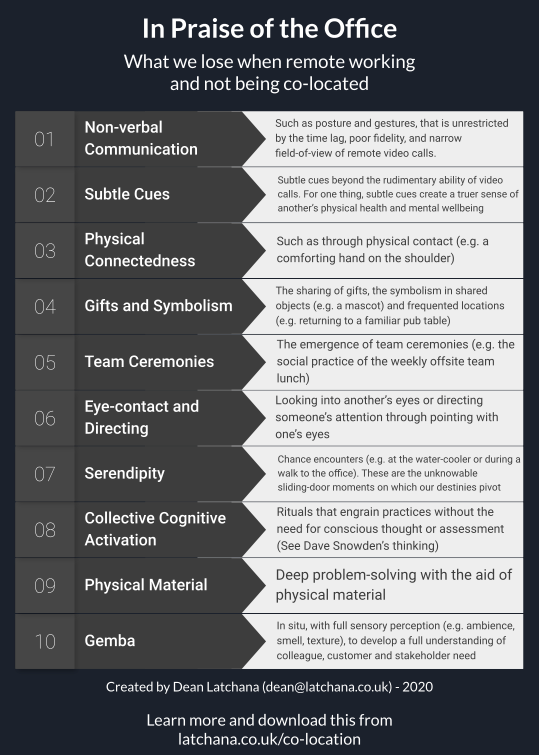The benefits of remote working
The COVID-19 lockdown has forced many to work from home in a sudden and unplanned manner. For those promoting the benefits of remote working, this is a long-waited and pivotal moment. It’s created an unexpected opportunity to recognise and endorse the benefits of remote working.
Before the lockdown, to name only a few constituents, remote working created a healthier work-life balance for many parents with young families, carers and long distant workers. It’s benefited CFOs looking to downsize office space.
The little-discussed disadvantages of remote working
Before the lockdown, the trend had been a move from the predominance of co-location (e.g. the office environment) to remote-working. Now, due to the lockdown, the remote working movement has accelerated. This has profound, and little discussed, trade-offs. These trade-offs are hidden by the novelty, and for some the allure, of our new working situation.
The lockdown has accelerated the remote working movement. This has profound, and little discussed, trade-offs. These trade-offs are hidden by the novelty, and for some the allure, of our new working situation.
So, after the lockdown, without a full appreciation of the consequences, how far will we take this movement?
For every decision, there are consequences, both beneficial and detrimental. Some are obvious; some only become apparent over time and through frank discussion.
This article is my opinion piece to kick-start that frank discussion.
My contrarian position
I value the efficiencies of working remotely, yet also recognise the creativity, connectedness and effectiveness which co-location enables.
I believe I’m fairly contrarian in advocating that, wherever practical, there should be a return to the office as soon as it is safe, with the benefits of occasionally working from home.
I’m not an absolutist. There are situations, times and activities which suits remote working.
However, the world is becoming more uncertain and complex. New threats and opportunities will emerge which necessitates the timeless ability for humans to collaborate in an immersive manner unimpeded by technological barriers. I believe this form of collaboration can only be achieved through the benefits of co-location.
New threats and opportunities will emerge which necessitates the timeless ability for humans to collaborate in an immersive manner unimpeded by technological barriers
What we lose when remote working
What follows is my initial list of the benefits that we lose when we are not co-located. I’m looking for collaborators to improve the list:
- Nonverbal communication such as posture and gestures that are unrestricted by the time lag, poor fidelity, and narrow field-of-view of video calls.
- Subtle cues beyond the rudimentary visual and auditory ability of video calls. For one thing, these subtle cues create a truer understanding of each other’s physical health and mental wellbeing
- Physical connectedness such as through physical contact (e.g. a comforting hand on the shoulder)
- The sharing of gifts, the symbolism in shared objects (e.g. a mascot) or frequented locations (e.g. returning to a familiar pub table)
- The emergence of team rituals and ceremonies (e.g. the social practice of the weekly offsite team lunch)
- Looking into another’s eyes or directing someone’s attention through pointing with one’s eyes
- Serendipity. Such as those chance encounters which occur at congregation points (e.g. at the water-cooler or during a walk to the office). Serendipity should not be underestimated; these are the unknowable sliding door moments which our destinies pivot upon.
- Collective cognitive activation (thank you Dave Snowden)
- Deep social problem-solving with the aid of physical material
- Being in situ, with fuller sensory perception (e.g. ambience, smell, texture), to develop a fuller understanding of colleague, customer and stakeholder needs. Think Gemba.
Serendipity should never be underestimated; these are the unknowable sliding door moments which our destinies pivot upon.
The advocates of remote-working may argue there are remote-working substitutes for items on this list. But substitution does not mean equivalence.
Perhaps they’d say I’ve overstated some items’ significance. Yet, I’m not aware of much objective research which may untangle, diagnose and back their convictions with evidence.
The Research
The only research I’ve found suggests remote working is best suited to routine work which requires no teamwork. What about complex work that necessitates close human collaboration and where there isn’t an obvious link between effort and performance?
Although our results suggest a promising future for working from home, we should note that several distinctive factors at Ctrip contributed to the success of the experiment and the practice’s implementation. First, the job of a call center employee is particularly suitable for telecommuting. It requires neither team work nor in-person face time. Quantity and quality of performance can be easily quantified and evaluated.
Does Working From Home Work? Evidence from a Chinese Experiment | Bloom, Liang, Roberts and Ying | Standford University, 2015
What do you think?
I don’t have all the answers. So what do you think? And where are the rigorous studies?
With this article, I’ve shared a strong belief that (I hope) is loosely held. So I’d be grateful for your views and input so we can learn together.
I’m seeking input from the likes of practitioners, businesses, thought-leaders, historians and research academics.

